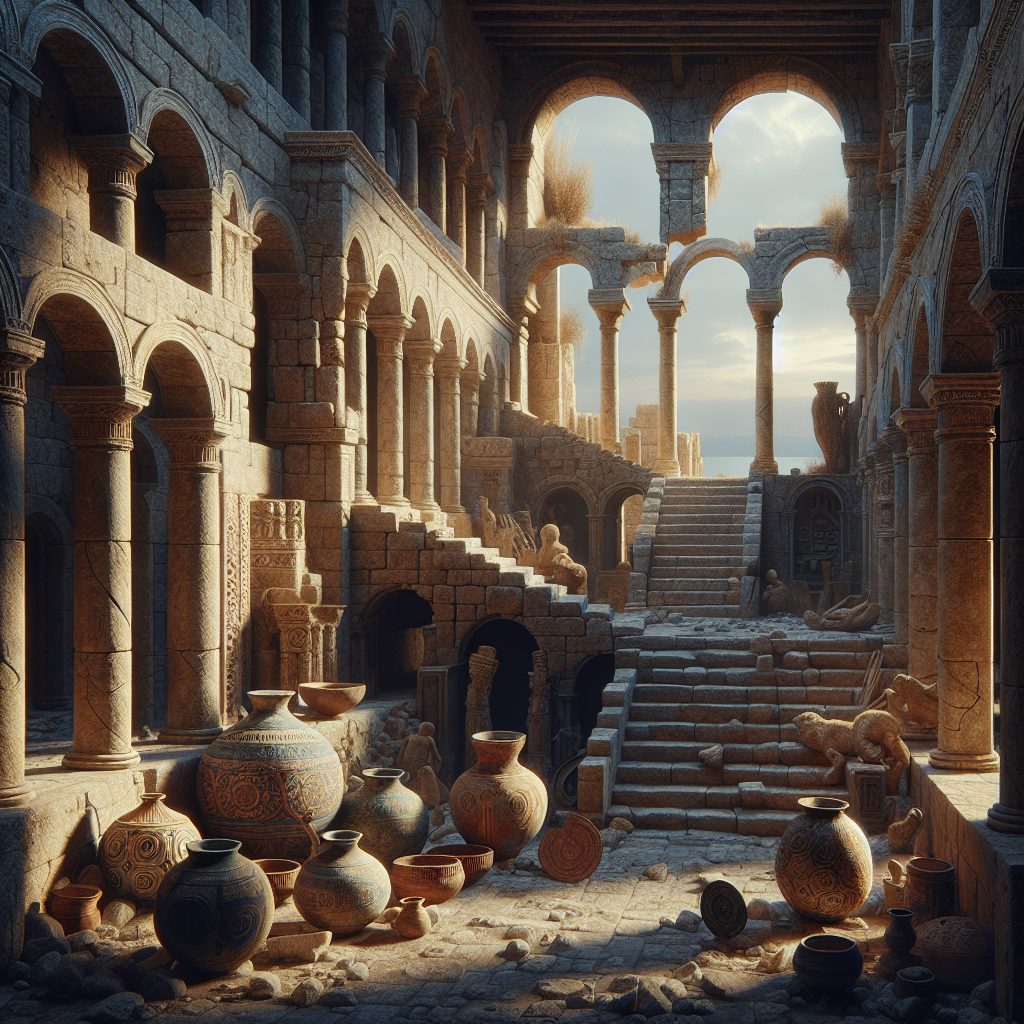Tharros ruins and the Phoenician culture are captivating subjects that offer a window into ancient history. Phoenicians, the seafaring people of the ancient Mediterranean, played a significant role in shaping the region’s culture, trade routes, and even the development of alphabets. Tharros, an archaeological site located on the west coast of Sardinia, Italy, stands as a remarkable testament to the Phoenician presence in the area.
At Tharros, visitors can explore the well-preserved ruins that showcase the unique characteristics of Phoenician architecture and lifestyle. The structures within the site, such as the mighty defensive walls and the remains of houses and temples, reveal the Phoenician’s mastery of construction techniques and their dedication to aesthetics. Moreover, Tharros offers insights into the economic activities of the Phoenicians, with features like the ancient port and the fish processing infrastructure. These remnants of the past provide a glimpse into the thriving maritime trade and fishing industry that formed the backbone of Phoenician society.
In the upcoming section, we will delve deeper into the key takeaways from exploring Tharros ruins and the Phoenician culture. By uncovering the significance of their trade networks and the influence of their alphabets, we will gain a deeper understanding of the widespread impact of the Phoenicians. We will also discuss the role of Tharros as a vital center for trade and exchange during ancient times. So, let us embark on this exciting journey to explore the rich history and impressive legacy of Tharros and the Phoenician culture.
Key Takeaways
1. Tharros ruins offer significant insights into the ancient Phoenician culture, located on the island of Sardinia, Italy. The ruins include various structures such as temples, houses, and fortifications, providing valuable evidence of the Phoenician civilization.
2. The Phoenicians established Tharros as an important trading center around the 8th century BCE, taking advantage of its coastal location and access to both the Mediterranean Sea and important trade routes. They thrived from maritime trade, connecting the Western Mediterranean region with the Eastern Mediterranean and beyond.
3. The cultural influence of the Phoenicians extended beyond trade, as archaeological findings in Tharros demonstrate. Unique artifacts, pottery styles, and burial practices suggest a blend of local Nuragic and Phoenician traditions, showcasing the cultural fusion that took place in the area.
4. Tharros also played a significant role in the spread of Phoenician alphabetic writing. Inscriptions found within the ruins contain the earliest known examples of the Western Phoenician script, contributing to the understanding of the Phoenician alphabet’s development and its diffusion through the Mediterranean.
5. The decline of Tharros occurred around the 5th century CE, mainly due to the overall decline of the Roman Empire. The city was abandoned and gradually covered by sand throughout the centuries, preserving its ruins until their rediscovery and excavation in the modern era. The Tharros ruins serve as a valuable testament to the historical and cultural legacy of the Phoenician civilization.
What are the historical Tharros ruins and how do they relate to Phoenician culture?
The History of Tharros Ruins
The ancient Tharros ruins, located on the western coast of Sardinia, Italy, hold significant historical value. These ruins date back to the Phoenician era, making them over 2,500 years old. Tharros was once a thriving Phoenician city that played a crucial role in trade and maritime activities in the Mediterranean region. It later fell under Roman rule, and its ruins now provide insights into the intermingling of Phoenician and Roman cultures.
Phoenician Culture
Phoenician culture refers to the customs, traditions, and way of life of the ancient Phoenician civilization. The Phoenicians were seafaring people primarily known for their maritime expertise, trade networks, and skilled craftsmanship. They established colonies and trading posts across the Mediterranean, including Tharros, as part of their vast influence in the region.
Architecture and Structures in Tharros Ruins
The Tharros ruins showcase various architectural elements that reflect the Phoenician influence. One notable structure is the “temple of antas,” featuring a mix of Phoenician and Roman architectural styles. The intricate details found in the ruins highlight the skilled craftsmanship of the Phoenicians.
Maritime Heritage of Tharros
Due to its strategic coastal location, Tharros was an important port city for the Phoenicians. Excavations of the ruins have uncovered remnants of the ancient harbor, including quays and moorings. The maritime heritage of Tharros provides valuable insights into the trading activities and seafaring culture of the Phoenicians.
Artifacts and Discoveries
Archaeological excavations at Tharros have unearthed numerous artifacts that shed light on Phoenician culture. These artifacts include pottery, jewelry, coins, and objects related to daily life, giving us a glimpse into the material culture and customs of the ancient Phoenicians.
Religious Practices and Beliefs
Religion held significant importance in Phoenician culture, and Tharros was no exception. The ruins contain evidence of religious structures and offerings, suggesting the existence of Phoenician religious practices in the area. Uncovering these religious aspects helps us understand the spiritual beliefs and rituals of the Phoenicians.
Trade and Economy in Tharros
Tharros was a bustling center for trade and commerce during its time. The ruins provide evidence of various trading activities, including the presence of warehouses and marketplaces. The Phoenicians’ expertise in maritime trade is evident in the remnants of trading networks and economic prosperity found within the Tharros ruins.
Visit Tharros and Explore Phoenician Heritage
If you’re fascinated by ancient civilizations and want to explore Phoenician culture, a visit to the Tharros ruins is a must. Walking through the ancient streets and marveling at the architectural remnants will transport you back in time. Take the opportunity to delve deeper into the rich history and cultural significance of the Phoenicians in this captivating archaeological site.
Looking to experience the Tharros ruins and Phoenician culture? Here’s what you need to know:
- Plan your visit during the mild season to enjoy favorable weather conditions.
- Wear comfortable shoes as the ruins require extensive walking.
- Engage a knowledgeable guide to fully appreciate the historical significance of the ruins and the Phoenician culture.
- Bring a camera or smartphone to capture memorable moments and the stunning panoramic views of the ruins.
- Respect the site by not littering and following any rules or regulations set by the authorities.
- Allocate sufficient time for your visit as there is much to explore and learn in Tharros.
- Take breaks and hydrate adequately, especially during the warmer months.
- Immerse yourself in the culture by trying local cuisine and learning about the region’s traditions.
- Support the preservation efforts of the Tharros ruins by donating or purchasing souvenirs from authorized vendors.
Frequently Asked Questions
1. What are the Tharros ruins?
The Tharros ruins are ancient archaeological remains located on the west coast of Sardinia, Italy. These ruins date back to the Phoenician and Roman periods and offer a glimpse into the rich and diverse history of the region.
2. What is the significance of the Phoenician culture?
The Phoenician culture was one of the most influential civilizations of the ancient world. Known for their seafaring skills, trade routes, and cultural exchange, the Phoenicians played a crucial role in shaping the Mediterranean region and its various societies.
3. What can I expect to see at the Tharros ruins?
When visiting the Tharros ruins, you can expect to see well-preserved ancient structures such as a Roman amphitheater, a temple dedicated to Tharros’ main deity, and remnants of Phoenician dwellings. Additionally, there are beautiful views of the sea and surrounding landscape.
4. How old are the Tharros ruins?
The Tharros ruins date back over two thousand years, with the Phoenician settlement believed to have been established around the 8th century BCE. The Roman influence came later, with significant developments during the 2nd and 3rd centuries CE.
5. Are there any guided tours available at Tharros?
Yes, there are guided tours available at Tharros that provide detailed insights into the ruins and Phoenician culture. These guided tours can enhance your visit by providing historical context and interesting facts about the ancient site.
6. Can I explore Tharros on my own?
Absolutely! Tharros is open to the public, and you can explore the ruins at your own pace. There are informative signs and information boards throughout the site, allowing visitors to gain insights into the significance of each structure.
7. Is Tharros suitable for children?
Tharros can be an educational and engaging experience for children, as it offers a tangible connection to ancient history. However, some areas may require supervision due to uneven terrain and the fragile nature of the ruins.
8. Are there any nearby amenities or facilities at Tharros?
While Tharros itself does not have amenities or facilities, there are nearby cafes, restaurants, and restrooms available for visitors. It’s advisable to carry water and snacks, as the ruins can be a sizable area to explore.
9. Can I take photographs at Tharros?
Yes, photography is permitted at Tharros for personal and non-commercial use. Capturing the beauty and historical significance of the ruins is encouraged, but please be respectful of the ancient structures and other visitors while doing so.
10. Are there any special events held at Tharros?
Tharros occasionally hosts cultural events, such as musical performances and theatrical shows, to celebrate the rich history and heritage of the site. It’s advisable to check with local tourism offices or visit their official website for upcoming events.
Final Thoughts
Exploring the Tharros ruins provides an immersive experience into the fascinating world of Phoenician culture. The ancient remains offer a profound glimpse into the past, allowing visitors to appreciate the architectural wonders and the historical significance of this enigmatic civilization.
Visiting Tharros is not just a journey through time but also an opportunity to reflect on the interconnectedness of cultures and the lasting impact they have on our present-day society. The remnants of the Phoenician culture serve as a reminder of our shared human history and the importance of preserving and appreciating ancient heritage.






